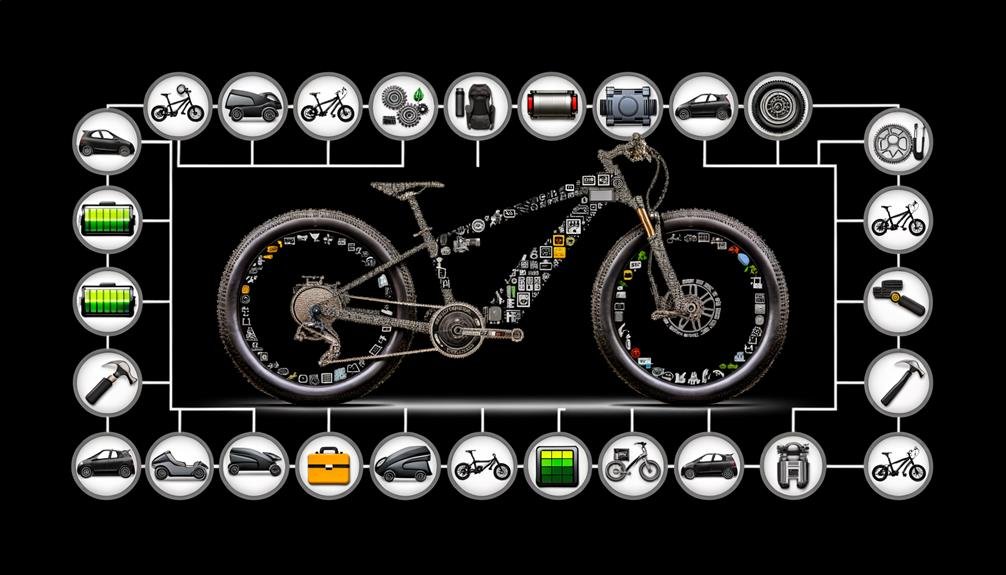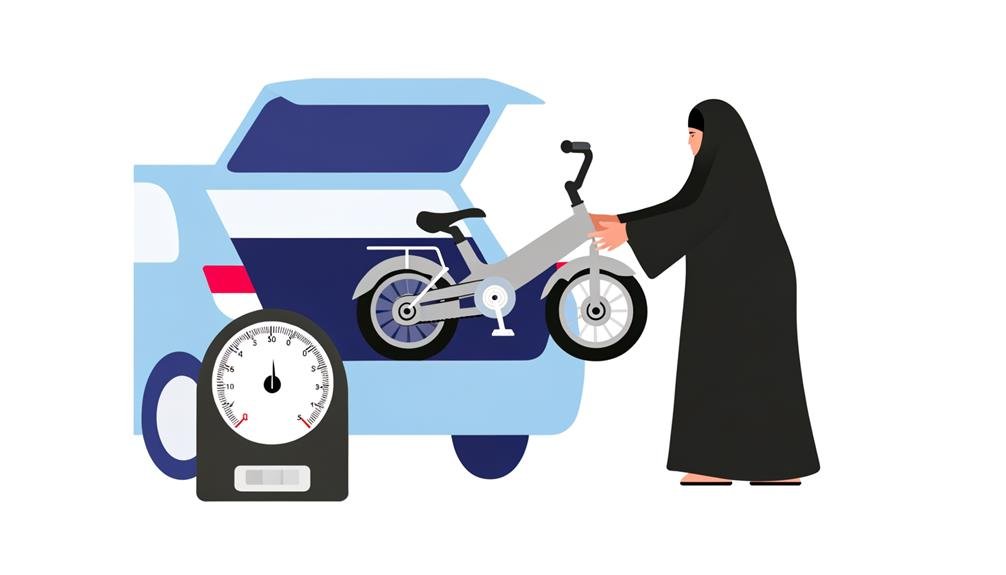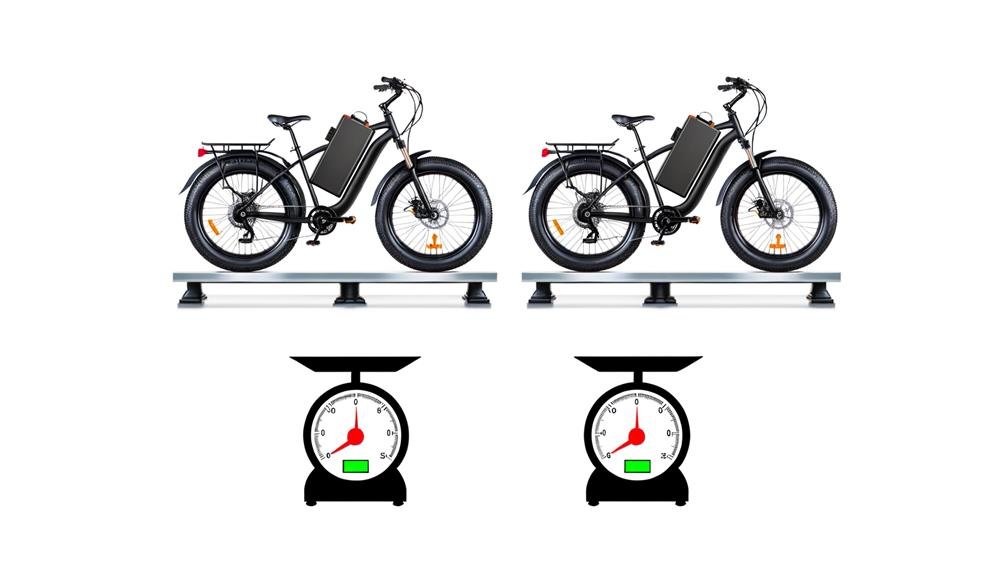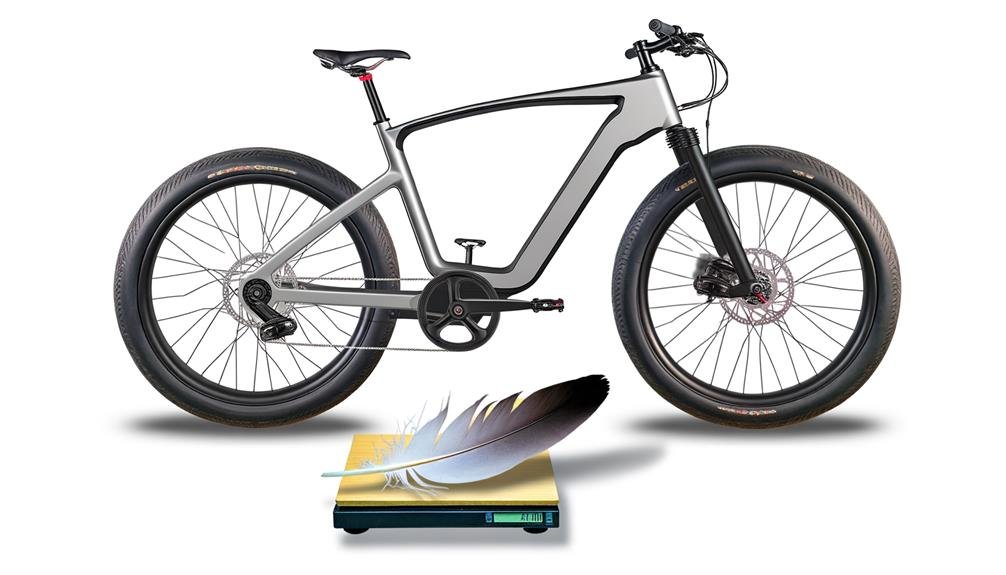Charles Miller is a veteran bike enthusiast with over 12 years of experience dealing with bikes as a mechanic. Despite immense love and expertise for...
In the world of electric bicycles, weight is a pivotal factor that significantly influences both the performance and maneuverability of the bike.
The weight of a Giant electric bike, a popular choice among e-bike enthusiasts, is determined by a multitude of factors including its frame material, battery size, motor type, and additional components.
While a lighter bike may offer enhanced ease of handling and transport, it is essential to consider the potential trade-offs in terms of power and battery life.
Thus, the question remains: just how much does a Giant electric bike weigh and what implications does this weight have on its overall performance and functionality?
This topic invites further exploration into the intricacies of e-bike design and the balance manufacturers must strike between weight, power, and performance.
- Key Takeaways
- Understanding Electric Bike Weight
- Importance of Bike Weight
- Giant Electric Bike Models
- Weighing the Giant Electric Bikes
- Factors Affecting E-bike Weight
- Comparing Giant Electric Bikes
- Transporting and Maneuvering E-bikes
- Giant Bikes: From Light to Heavy
- Impact of Battery on Bike Weight
- Making Lighter Giant Electric Bikes
- Frequently Asked Questions
- Conclusion
Key Takeaways
- The weight of a Giant electric bike can vary depending on the model, with some weighing as little as 18.8kg and others weighing over 23kg or even more than 50 pounds.
- The weight of an electric bike is influenced by factors such as the material composition of the frame, the weight of the battery and electric motor, the size and power of the battery, and the additional components and accessories.
- The weight of an electric bike has implications for its stability, durability, range, and maneuverability, with lighter bikes offering swifter handling but shorter range, while heavier bikes may have greater battery capacity and longer range.
- The material composition of Giant electric bikes includes aluminum and carbon fiber frames, which are lighter, and lightweight components are used to maintain a balance between weight and performance.
Understanding Electric Bike Weight
An appreciation of electric bike weight, specifically, the nuances involved in their heftier construction, is integral to understanding their design, performance, and overall functionality. The Giant Trance X E, for instance, stands as a testament to this fact. Weighing 19kg, it is 4kg lighter than its predecessor, a testament to Giant's commitment to enhancing the user experience.
The weight of electric bikes, including the Giant series, is often attributed to the integration of the motor and battery. For example, the Trance X E+ houses a SyncDrive Pro 2 motor coupled with a compact, yet powerful 400Wh battery weighing just 2.3kg. This combination of electric motor and battery contributes significantly to the overall weight of the bike, which is generally around 20 pounds heavier than traditional bikes.
It is crucial to note that e-bike weight varies based on type. Folding e-bikes typically weigh between 30-80 pounds, commuting e-bikes range from 50-70 pounds, while mountain e-bikes like the Trance X E commonly weigh around 70 pounds.
Though the additional heft may seem cumbersome, managing the extra weight can be done by considering the bike's purpose, regular cleaning, and removing unnecessary attachments. Thus, understanding the weight of an electric bike, particularly the Giant range, allows for an optimized riding experience.
Importance of Bike Weight
The weight of an electric bike plays a substantial role in its overall performance and ride experience. As an essential factor, it significantly influences the bike's stability, durability, and range, thus directly correlating to its functionality and utility.
Understanding these implications is crucial for potential owners to make informed purchasing decisions and effectively manage their e-bikes.
Bike Weight Implications
Understanding the implications of an e-bike's weight, which is typically increased by around 20 pounds due to the addition of batteries and electric motors, is critical for both performance and convenience.
This is particularly true for a Giant electric bike, equipped with a SyncDrive Pro 2 motor and a new battery. Although the bike weight implications might seem daunting, Giant's cutting-edge technology ensures a balance between weight and power.
The Giant SyncDrive motor is claimed to weigh less than other motors, assisting in maintaining a light weight. Furthermore, the new battery design contributes to further weight reduction, without compromising the durability and power output.
Thus, careful consideration of the motor and battery is essential for understanding the weight implications of a Giant electric bike.
Weight and Performance Correlation
While the innovative design of the Giant electric bike successfully mitigates some weight implications, it remains crucial to examine the correlation between the weight and performance of e-bikes.
Models such as the Giant Trance X Advanced, Trek Fuel EXe, Specialized Levo SL, and Pivot Shuttle SL represent a spectrum of electric mountain bikes, each with distinct weight and performance characteristics.
The battery capacity and the SyncDrive Pro motor, two key components of e-bikes, significantly contribute to their overall weight. A heavier bike may offer greater battery capacity and thus longer range. However, it may also hinder maneuverability, especially uphill.
Conversely, a lighter e-bike might offer swifter handling but a shorter range. Therefore, understanding the weight and performance correlation is essential when choosing an e-bike.
Giant Electric Bike Models

Exploring the models of Giant Electric Bikes, the 2023 Giant Trance X E+ stands out due to its significant weight reduction and innovative design, maintaining a weight of only 19kg. This new bike is a striking example of the brand's commitment to pioneering e-bike technology. It is equipped with a SyncDrive Pro 2 electric motor that offers smart assist and 85Nm of peak torque.
The Trance X Advanced E+ Elite 0 is claimed to be even lighter, weighing only 18.8kg, thanks to new battery cell technology specifically developed for e-bike usage. This model, like the new Trance X E, demonstrates the brand's ability to pack a whole lot of power and performance into a lightweight frame.
| Model | Weight (kg) |
|---|---|
| Trance X E+ | 19 |
| Trance X Advanced E+ Elite | 18.8 |
| Specialized Levo | 23 |
| Trek Rail | 23 |
This table highlights the impressive weight reduction achieved by Giant Electric Bikes, setting a new standard for e-bike design and functionality. It's clear that Giant's emphasis on innovation is creating more accessible and enjoyable e-biking experiences.
Weighing the Giant Electric Bikes
In the realm of e-bikes, the weight of the bike plays a pivotal role in determining the bike's performance and ride quality, as evidenced in the various models of Giant Electric Bikes. The new Giant Trance X, for example, weighs in at 19kg, 4kg lighter than its predecessor. This new electric mountain bike benefits from advancements in battery technology, specifically a lighter 400Wh battery that weighs just 2.3kg.
The E+ Elite is designed with weight optimization in mind. The Giant Trance X E+ Elite features a weight of 18.8kg, again demonstrating Giant's commitment to reducing the overall weight of their electric bikes.
On the other hand, the Giant Roam E+ GTS, a different model, weighs over 50 pounds, indicating that while Giant prioritizes weight reduction, the final weight can vary significantly depending on the model and its specific features.
Factors Affecting E-bike Weight

The weight of an e-bike is not a function of its size alone; the material composition of the bike, as well as the weight of its battery and motor, are key determinants.
For instance, frames made of aluminum or carbon fiber are typically lighter than those made from steel, impacting not only the weight but also the bike's overall performance and rider's ease of use.
Additionally, the battery and motor, essential components for the e-bike's functionality, contribute significantly to the bike's weight, with larger or more powerful versions implying a heavier bike.
E-bike Material Composition
While considering the overall weight of an e-bike like the Giant Electric Bike, it's crucial to account for key factors such as the battery, electric motor, and the e-bike material composition. The frame, often made from Grade Carbon Fibre, significantly affects the bike's weight, offering strength with minimal heft. Other components like the Giant AM Alloy Rims or Zipp 3Zero Moto wheels and the Praxis Alloy 36T Crankset also contribute.
| Component | Material |
|---|---|
| Frame | Grade Carbon Fibre |
| Rims | Giant AM Alloy/Carbon Rims |
| Crankset | Praxis Alloy 36T |
Choosing lightweight components like the Giant Contact SL can help maintain the balance between weight and performance, crucial for the exceptional ride quality we all desire in our Giant electric bikes.
Battery and Motor Weight
Shifting our focus to the elements of battery and motor weight, it becomes evident that these components substantially influence the overall weight of a Giant electric bike.
The powerful motor, SyncDrive Pro 2, has a significant impact on the bike's weight due to its robust output.
The battery inside, a sleek 400Wh unit, adds to the weight but also boosts total capacity, ensuring a longer ride on a single charge.
The addition of a range extender battery significantly increases the bike's weight but also extends its range, a feature accessible through the RideControl app.
This battery that's cleverly concealed in a specially designed bottle cage, while adding heft, allows riders to traverse longer distances, further enriching the e-biking experience.
Comparing Giant Electric Bikes
In comparing the various models of Giant Electric Bikes, it's imperative to delve into the nuances of their weight, power, and range to understand how each bike suits different rider needs and terrains. The Giant Trance X E+ weighs 19kg and is built around the SyncDrive Pro 2 motor which offers 85Nm of peak torque. This model is part of the E+ Elite lineup that has been designed for performance-oriented rides over a variety of terrain.
The Giant Roam E+ GTS weighs a bit more at 22.5 kg but has an impressive range of up to 55km, making it an excellent choice for longer rides. On the other hand, the Giant Trance X Advanced E+ Elite, also part of the E+ Elite lineup, weighs only 18.8kg, showcasing the technological advancements Giant has made in reducing bike weight without compromising on power and range.
| Bike Model | Weight | Range |
|---|---|---|
| Giant Trance X E+ | 19kg | N/A |
| Giant Roam E+ GTS | 22.5kg | 55km |
| Giant Trance X Advanced E+ Elite | 18.8kg | N/A |
| Liv Intrigue X Advanced E+ Elite | N/A | N/A |
Transporting and Maneuvering E-bikes

Navigating the complexities of transporting and maneuvering e-bikes necessitates an understanding of their weight spectrum, which can range from 30 to 80 pounds depending on the type and design of the bike.
For instance, a brand new giant electric bike like the 2023 Giant Trance X E+ falls within the 40-70 pounds range, heavier than a regular non-electric bike, yet manageable thanks to its electric motor.
However, the bike weight becomes a significant factor when planning longer rides or when there's a need to carry the bike. For example, a step-through e-bike might accommodate various riders but weighs over 50 pounds, thus choosing a bike rack for transportation needs careful consideration.
On the other hand, advancements such as the Contact SL Trail handlebars or the RideControl Go console have led to weight reductions in models like the Giant Trance X Advanced E+ Elite, enhancing the maneuverability without compromising the bike's performance.
Giant Bikes: From Light to Heavy
While considering the weight influence on the maneuverability of e-bikes, it's equally essential to explore the weight variations among Giant bikes, ranging from the lightest to the heaviest models. Indeed, the weigh of a Giant electric bike can significantly alter your riding experience.
To give you a clearer understanding, let's consider two distinct models among the spectrum of Giant bikes:
- The Giant Trance X E+, a lightweight model, weighs in at 19kg. It's lighter than many popular e-MTBs, thanks to the SyncDrive Pro 2 motor and a smaller 400Wh battery weighing just 2.3kg.
- On the other end of the scale, the Giant Roam E+ GTS weighs over 50 pounds. Despite its heft, it offers a blend of ruggedness and comfort for versatile terrain handling.
These variations in bike weigh not only influence maneuverability but also determine the type of terrain suitable for the bikes. Understanding these weight differences is essential for choosing the right electric bike to suit your riding style and environment.
Impact of Battery on Bike Weight

The weight of the battery is a significant factor in the overall weight of an electric bike. Its size and weight have a direct influence on the bike's performance, with larger batteries often leading to a heavier bike, but extended range.
It is therefore essential to consider the weight and capacity of the battery while choosing a lightweight electric bike.
Battery Weight and Size
Giant Trance X E+'s implementation of a lighter, smaller 400Wh battery, which weighs a mere 2.3kg, significantly reduces its overall weight, highlighting the pivotal role of battery size and weight on the entire e-bike's weight and performance.
The reduced battery weight and size caters to the trail e-MTB market, paving the way for the X E+ into unique territory.
The battery is seamlessly integrated into the frames, enhancing the aesthetic appeal of the giant electric bike.
It complements the Maestro dual-link suspension, ensuring a smooth ride without compromising on power.
The RideControl Ergo 3 remote allows easy access to battery charge information.
The lighter weight makes the X E+ one of the most maneuverable e-MTBs on the market.
These aspects underline the importance of battery weight and size in shaping the performance and user experience of an e-bike.
Battery's Influence on Performance
As a critical component of the Giant Trance X E+, the Panasonic-manufactured 400Wh battery, notable for its compact size and light weight of just 2.3kg, significantly impacts the bike's overall weight and performance.
This reduction in battery weight propels the E+ into unique territory, bridging the gap between lightweight and full-powered e-MTBs.
The battery's influence on performance is not just about weight. The option to augment the bike's range with a 200Wh range extender further exemplifies the strategic role the battery plays. Even with the added weight, the bike's performance remains superior due to the perfect balance between weight and power.
This synergy confirms the Giant electric bike's prowess in offering an unparalleled riding experience, where every component influences the final outcome.
Choosing Lightweight Bike Batteries
Building upon the understanding of the battery's role in performance, it becomes imperative to examine the impact of choosing lightweight bike batteries on the overall weight and operational capabilities of electric bikes such as the Giant Trance X E+.
- Lightweight battery design can significantly reduce the overall weight of an electric bike, resulting in enhanced maneuverability and performance.
- Advanced cell technology in batteries such as the EnergyPak 400 in the Trance X E+ Elite contributes to minimizing weight while providing full power.
- The 400Wh Panasonic battery, the cheapest option on the Trance X E+, offers a more agile and maneuverable riding experience.
- The weight of the battery should be a key consideration when selecting a new bike.
- It's essential to assess the trade-off between battery weight and capacity, demonstrated in 121-kg Intrigue X Advanced E.
Making Lighter Giant Electric Bikes

In the pursuit of enhancing riding efficiency and enjoyment, significant strides have been made in creating lighter models of Giant electric bikes, such as the 2023 Trance X E+ which boasts a new frame and battery design for substantial weight reduction. This model integrates the SyncDrive Pro 2 motor with 85Nm peak torque and a smaller, lighter 400Wh battery, making lighter the operative term in its design philosophy.
The frames top tube is specially designed to accommodate a range extender battery, seamlessly incorporated without compromising the bike's weight. Along with carbon Praxis elements, this design optimizes weight distribution and efficiency. The Trance X E+ Elite also features a w/Praxis Alloy 36T Crankset, further reducing weight while enhancing performance.
The Fox Float Live Valve suspension and Fox Transfer Factory dropper post provide efficient control while maintaining a lightweight profile. This strategy of making lighter Giant electric bikes results in a versatile, efficient, and enjoyable ride, bridging the gap between lightweight and full-powered e-MTBs.
For further insights into the weight and design features of Giant electric bikes, feel free to contact us. Together, we can explore the world of lighter, more efficient e-biking.
Frequently Asked Questions
How Much Should an Electric Bike Weigh?
The weight of an electric bike varies greatly, typically between 18-25kg. Factors such as battery weight, frame materials, and weight distribution impact performance and pedal assistance, while weight limitations affect transport considerations.
Are Electric Bikes Heavy to Lift?
Electric bikes can be heavy to lift due to factors like bike materials, battery influence, and frame size. However, proper lifting techniques and portable options can manage this. The design impact and weight capacity also matter.
Why Are Ebikes so Heavy?
E-bikes are heavy due to battery weight, motor inclusion, and frame modification. The component materials and power requirements add to this weight. Despite the durability factor and performance trade-offs, these design challenges ensure efficient operation.
How Much Does a Giant Roam Weight?
The Giant Roam E+ GTS weighs around 22.5 kg, offering robust durability and impressive off-road performance. Despite its weight, the Roam's maneuverability, comfort aspects, speed, and battery capacity justify the price and maintenance frequency.
Conclusion
In conclusion, the weight of a Giant electric bike can vary greatly, influenced by factors such as model and specific components.
However, advancements in technology and engineering, such as the evolution of battery cell technology, have allowed for a significant reduction in weight, as exemplified by the 2023 Giant Trance X E+ Elite.
This serves as a testament to the continuous efforts in the e-bike industry to optimize performance through weight reduction, without compromising on strength and stiffness.

Charles Miller is a veteran bike enthusiast with over 12 years of experience dealing with bikes as a mechanic. Despite immense love and expertise for his Tacoma, he rides his Trek Ebike more. Anytime you meet him, you’ll either hear him talking about Bikes, or writing about all things bikes and cars on this blog.
More Posts


